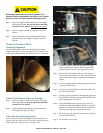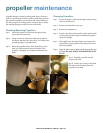
Step 9: Cover the boat with a boat cover or tarp.
Note: If the boat is to be stored outside and subject to accumu-
lations of snow, water and ice, a support should be made for the
boat cover so that it will not sag, rip or tear, thereby allowing
water to enter the boat. Two-inch diameter PVC plumbing pipe
is ideal for this purpose. It is readily available at local hard-
ware stores, and it is easy to work with. Also, its rounded shape
will prevent damage to the canvas.
Ballast System Preparations
Step 1: Attach a hose to the starboard side ballast hose that
comes out of the deck at the rear seat.
Step 2: Place the other end into a gallon of non-toxic, RV-type
anti-freeze.
Step 3: Turn the pump on to empty and pump anti-freeze into
the system until anti-freeze comes out of the thru-hull
on the side.
Step 4: Turn the pump on to ll and pump anti-freeze back
into the jug.
Re-Activating the Boat After Storage
Step 1: Remove the duct tape from the exhaust aps.
Step 2: Fully charge the battery and install it in the boat, fol-
lowing all safety precautions associated with changing
batteries.
Step 3: Follow all instructions for reactivating the drive train as
detailed in the engine owner’s manual. NOTE: Due to
the complex nature of the reactivation process, Master-
Cra recommends having an authorized MasterCra
dealer perform this function.
Step 4: Ensure that all drain plugs throughout the boat and
drive train have been reinstalled to avoid unwanted
intrusion of water.
Step 5: If applicable, reconnect the hoses to your heater or shower.
Step 6: Check the engine compartment and bilge for signs of
nesting animals. Clean as necessary.
Step 7: Check the entire engine system for uid, oil and cool-
ant levels. Add as necessary.
Step 8: Check the entire engine for cracks or leaks caused by
freeze damage.
Step 9: Check all hose clamps for tightness. Install the bilge
drain plug and the rear drain plug in boats equipped
with certain types of ballast systems.
Step 10: Grease the propeller sha taper and install the propeller.
Step 11: Fully re-charge and re-install the battery or batteries.
Step 12: Perform the daily maintenance as noted previously in
this Owner’s Manual. If it was not done prior to stor-
age, perform the annual maintenance as well.
Step 13: If the boat is equipped with the optional fresh water
cooling system and was drained for storage, ll the
system with fresh coolant solution per instructions.
Step 14: Check the alignment between the output ange on the
transmission and the propeller sha ange. If the maxi-
mum feeler gauge that can clip between the ange faces
at any point is 0.003”, the unit is properly aligned. If a
thicker gauge can be inserted at any point, the engine
must be re-adjusted until proper alignment is obtained.
is should be performed by an authorized Master-
Cra dealer’s service department.
Step 15: For all models, with the boat in the water, cycle the key
ON and then OFF two (2) or three (3) times, allowing
ten (10) seconds between key cycles, before cranking
the engine. is allows the fuel pump to prime the fuel
lines; then start the engine. In the event the engine does
not respond, allow a two-minute cool-down period for
every thirty (30) seconds of cranking. When the engine
res, keep a close watch over the gauge readings and
check for leakage and abnormal noises. Keep speeds
low for the rst een (15) minutes to allow the engine
to reach normal operating temperatures.
Step 16: In ProStar 197s equipped with ballast bags, when re-
connecting the hook-ups, be sure to squeeze the prongs
to help slide the connector back on. Dish soap or some
similar product will help slide the connects back to-
gether. Note that the red ring goes over the raised ring
to ensure a working connection.
MasterCraft 2009 Owner’s Manual - Page 17-3


















